ALERT!
Wasps In Utah: What types of wasps are in Utah?
With its ever-changing weather, Utah residents often wonder what types of pests live in Utah. Better yet, how to get rid of these bothersome insects.
Here, we’ve compiled everything you need to know about species of wasp in Utah, and how to exterminate them.
Social Wasps
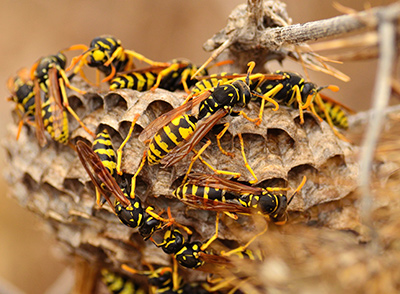
Firstly, What You Should Know:
- Hornets, Yellow Jackets and Wasps are all members of the closely-related social wasp family in Utah.
- What sets social wasps apart? All social wasps are capable of repeatedly stinging without dying (like a bumble bee would), whenever they feel threatened.
- Although bees are often the point-of-blame for most stings, about 90% of those stings are caused by Yellow Jackets.
- Most social wasps are predatory of other insects, therefore are considered to be very beneficial to our ecosystem.
- Though social wasps provide natural insect control, they are still considered a nuisance pest when near humans.
What types of wasps are in Utah ?
Common wasps in Utah:
Tarantula Hawk –
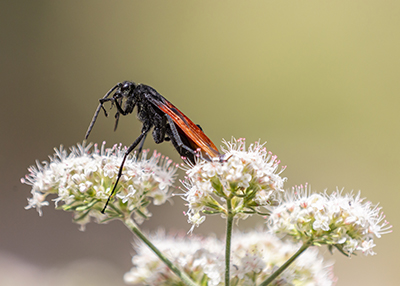
Tarantula hawk wasps reach approximately 2 inches in length, and have blue-black bodies. In addition, tarantula hawks have bright orange wings. Some refer to these insects as “black wasps” or “tarantula wasps”. The name tarantula hawk comes from the fact that these wasps will actually hunt and eat tarantula spiders.
Only female tarantula hawk wasps have a stinger, the males do not. Typically, these wasps don’t pose a threat and will only sting when feeling very threatened. That said, their stings are incredibly painful. In fact, it’s said that a sting from the this type of wasp may just be the most painful of any other U.S. insect. Researchers think that, due to the fact that tarantula hawk wasps have very few natural predators, their most effective deterrent mechanism is a really painful sting.
Paper Wasp –
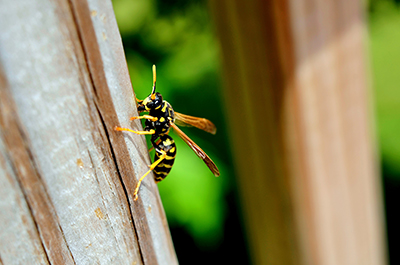
In the state of Utah, there are 4 species of paper wasps. The most common species is the Western paper wasp. However, the European paper wasp is quickly becoming the dominant species. The adult paper wasp is significantly more slender than yellowjackets or hornets, and have longer legs which dangle during flight. Queen paper wasps reach around ¾ of an inch, where workers grow to be ½ of an inch in length. These wasps have a particularly distinct waist and appear smooth and/or hairless. In color, paper wasps range from dark brown, orange or red in color. That said, some adult paper wasps are confused with yellowjackets.
As with most wasps, the paper wasp is considered a predator of many other insects. Workers will collect caterpillars and other immature insects in order to feed their colony. Sometimes, paper wasps will get a sweet tooth and seek out sugar through fruit trees or humans garbage. The paper wasp nest looks the most like what you’d imagine a bees nest would look like, with octogonal shaped openings throughout.
Hornets –
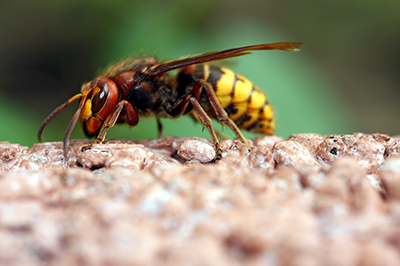
There are at least 4 species of hornets in Utah. The most common species is known as the “baldfaced hornet”. That said, the baldfaced hornet is actually not a true hornet, but an aerial-nesting yellowjacket. Adults look strikingly similar to yellowjackets, with a smooth exterior and black with yellow-to-white bands of color. Queen hornets will grow to be about ¾ of an inch, with workers growing to approximately ½ of an inch. Hornet nests look sort of like they were made out of paper, and are usually located in trees or along structures or homes.
Contrary to common belief, hornets are much more docile than yellowjackets, and will rarely sting unless they are persistently threatened. Hornets are considered beneficial predators of other insects, and will bring back food for growing larvae. As with most wasps, hornets crave sweets and will feast on your fruit trees.
Yellowjacket –
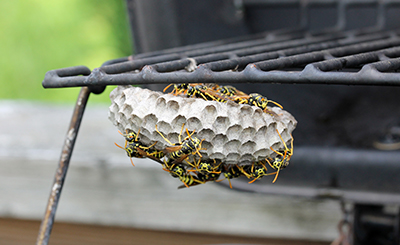
In the state of Utah, there are at least 5 different types of Yellowjackets. That said, the most common species is the Western yellowjacket. Adults are smooth, with yellow and black bands of color. The queen yellowjacket will grow to be about ¾ of an inch in length, with the workers reaching about ½ of an inch. Generally speaking, yellowjackets are stout and big-bodied wasps. They are easy to distinguish from bees, due to their lack of body hairs and for their uniquely distinct waist (small). Yellowjackets are known to be more aggressive than other social wasps or bees, and will absolutely sting if threatened.
Common yellowjacket nests look like small hole-type openings in the dirt. Yellowjackets are considered to be “scavengers”, eating just about anything from dead insects to garbage. Adult yellowjackets are attracted to the smell of sweet foods, such as fruit and candy, and will seek out carbohydrates over any other food group. If you have fruit trees in your yard, it is especially important to avoid a yellowjacket infestation, as this can result in the death of your fruit crops.
Social Wasps –
As previously stated, social wasps are a grouping of wasps that include hornets and yellowjackets.
How to get rid of wasps in Utah?
Great question!
Wasps are a common complaint of many who reside in Utah. This is due to their painful stings and inconvenient nesting choices. Because wasps travel together, if you see one in your yard, there’s likely to be many more around the area. If you find yourself in the middle of a wasp infestation, try the following removal techniques before contacting an exterminator:
- Check all areas where wasp nests could be built. This includes, but is not limited to, around the roofing of a home, around large tree branches or the sealing along windows. Small nests can usually be removed without too much of a fuss. However, large nests may need professional removal.
- If you discover a place where wasps are continuing to create their nests, put a light in that area. This will help prevent a wasp nest from being re-built there.
- Be sure to seal off any areas where wasps nest have been, and cover all soffits.

